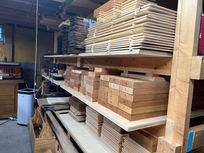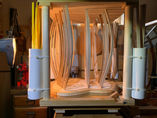
DESIGN
hand crafted - tradition - innovative - unique - responsible - finish


BUILDING PHILOSOPHY
The design and construction of Eagle Guitars are based mainly on traditional concepts and techniques. With many mistakes along the way (making expensive firewood), I now build with more hand tools and fewer jigs. Why build guitars if you don't want to work the wood with your hands? The dependence on power tools can keep the builder from getting to know the properties of the wood when shaping it by hand. Each species of tonewood has different tonal properties. Added to the challenge, rarely do two pieces of the same size and species of wood sound or vibrate the same way. I work from consistent notes and procedures used in my previous builds, carefully making small changes to the wood of each new guitar construction based on what my brain, eyes, ears, and touch tell me. As with most builders, my construction and building choices add more focused trebles in my classical guitars and more focused bass in my steel-string guitars. The soundboard and body of the guitar is a 'pumping drum' activated by the string vibrating through the bridge.
Very few (if any) building techniques these days are original ideas. What might be considered original is how each luthier combines old and newer concepts into one consistent building style that can be repeated and improved with each new build. Some of the latest construction and design techniques (double tops, falcate, Kasha & lattice bracing, sound ports, carbon fiber, alternative wood for soundboards, and elevated fingerboards) have been around for many years. I embrace all of these building techniques but with caution, balance, and a focused purpose in mind. In my opinion, some luthiers who build using double tops and alternative bracing patterns sacrifice the inherent richness and delicacy of traditional tone (especially in classical guitars) for the sake of having a more robust volume and projection.
My focus for steel-string guitars is on parlor size instruments with shorter scale lengths. As a player, hands and body have always been more comfortable with a small guitar. These small guitars' traditional use was for strumming the accompaniment to support a singer. More and more, they are being used as solo instruments or for fingerpicking. I'm building and designing these guitars for the 'picker,' and the soloist, with more volume and bass. The clarity of a solid initial attack of each note is essential. Bass response becomes critical to a guitar that has inherent overpowering trebles.
The traditions found in the classical guitar's look, build, and sound are slow to change. For me, this means a warm sound that has focused notes, sustain, and lively overtones throughout the length of the fingerboard. With any newer construction methods in my classical builds, my goal is to enhance the traditional sound (to my ears!) and elevate the guitar's responsiveness.
In every build, my goal is to enhance the instrument's responsiveness. Whether it's a classical or steel-string guitar, there are ways to alter the construction to accommodate the repertoire and style of the player.
- Steven A. Daigle


Workshop
EAGLE GUITARS
























